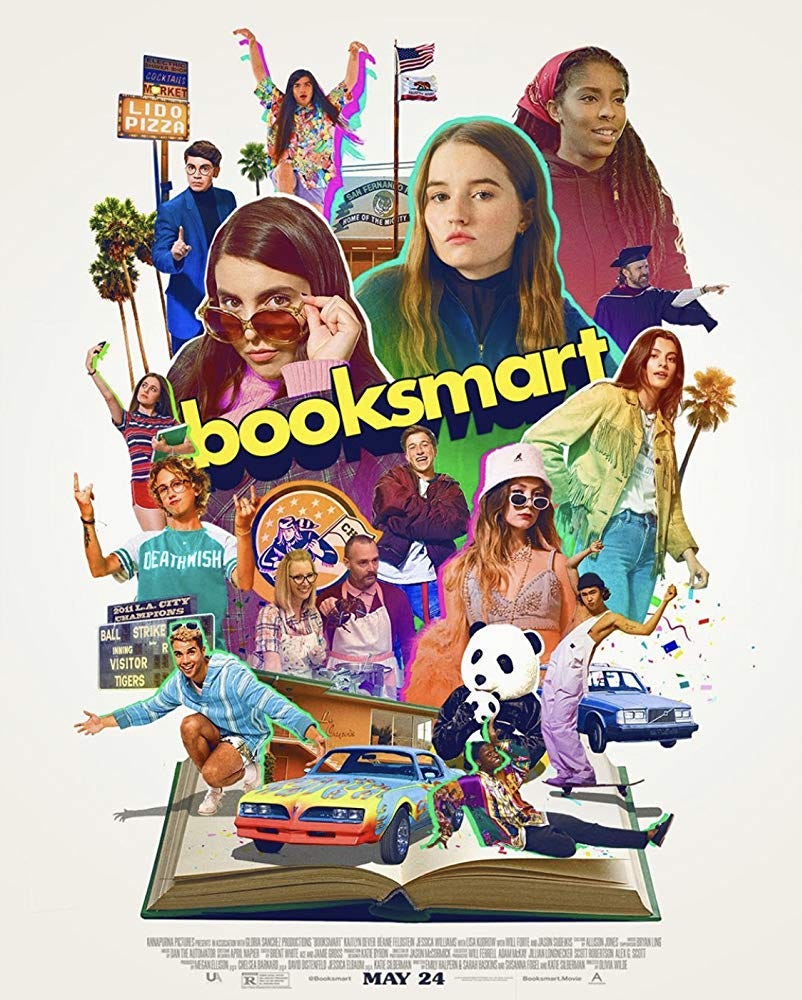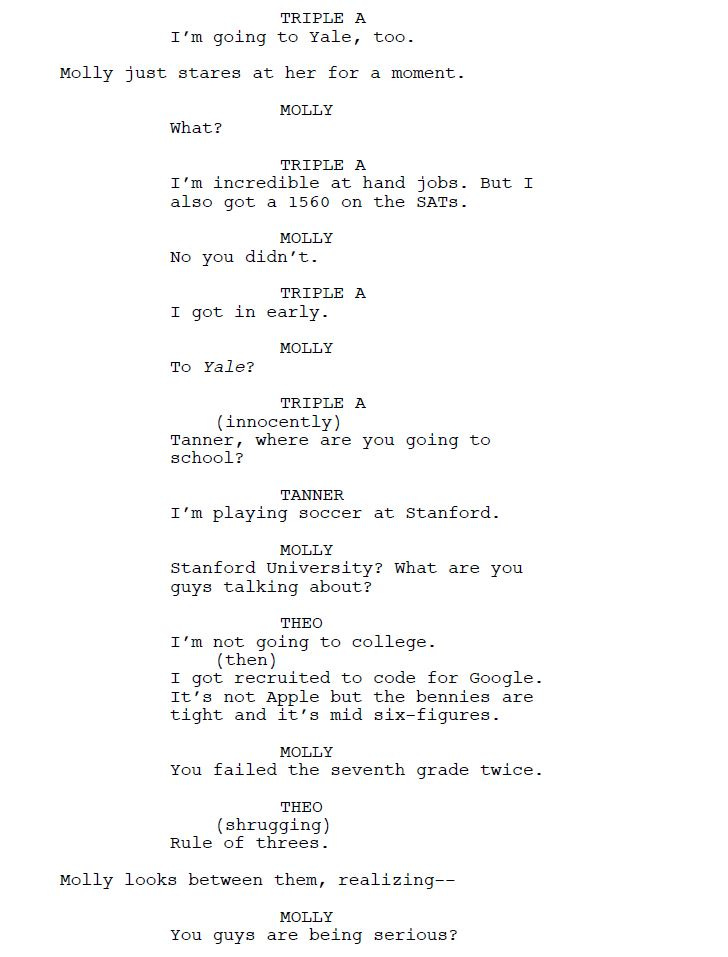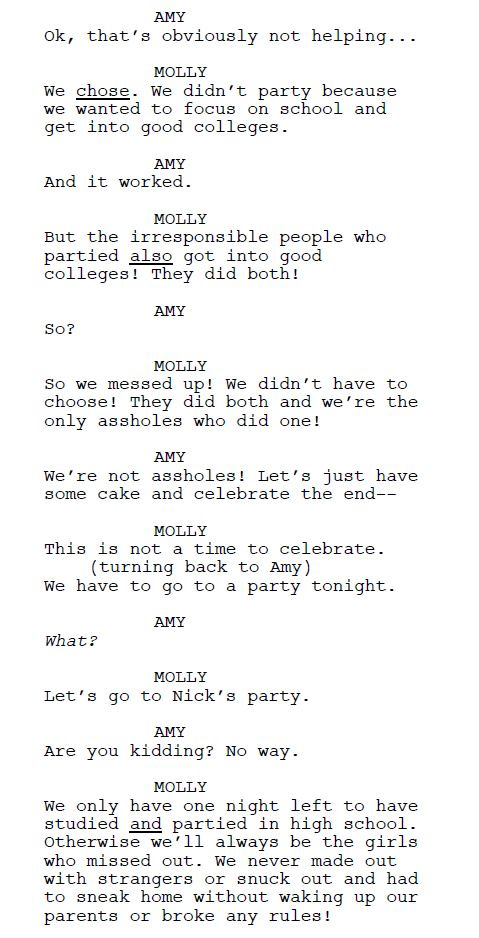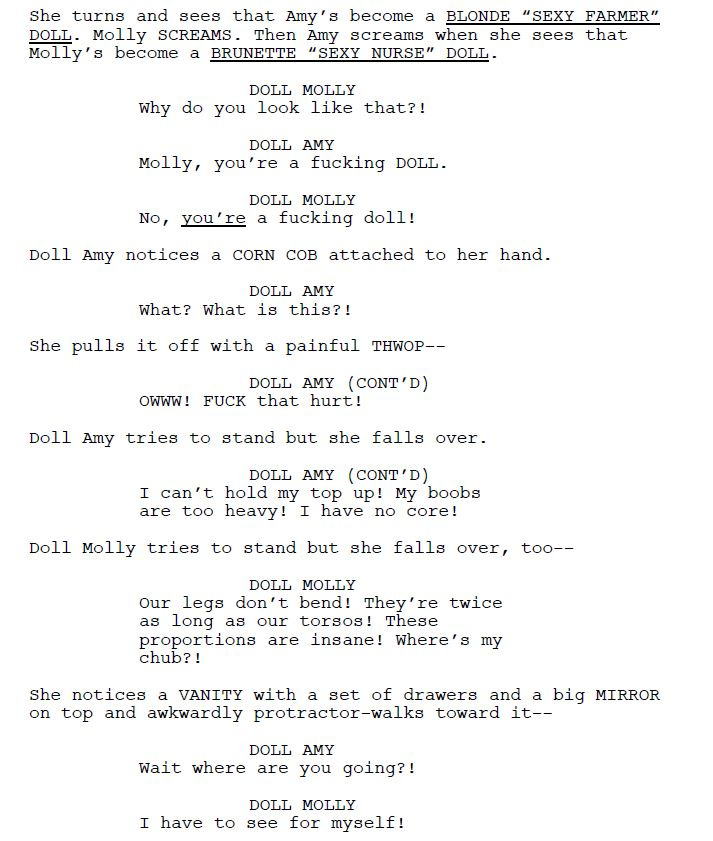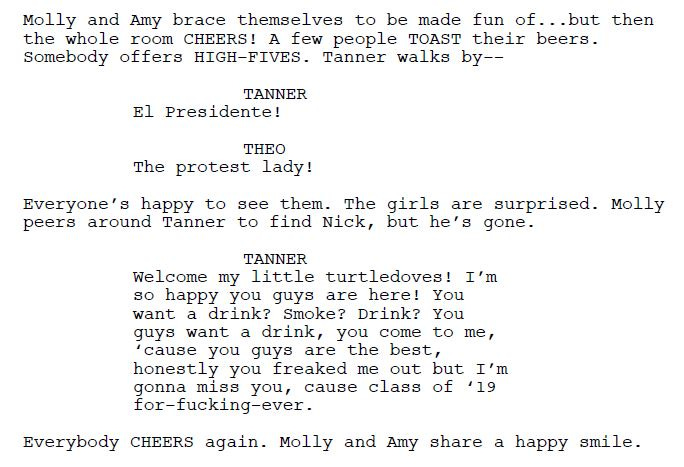Booksmart (2019) Script Review | #69 WGA 101 Greatest Scripts of the 21st Century
Booksmart is a female-flavored twist on Superbad for Gen Z that promises to be a classic in the vein of a John Hughes movie.
Logline: On the eve of their high school graduation, two academic superstars and best friends realize they should have worked less and played more. Determined not to fall short of their peers, the girls try to cram four years of fun into one night.
Written by: Emily Halpern & Sarah Haskins and Susanna Fogel and Katie Silberman
Pages: 104
Booksmart is the answer to the question: What if Superbad (#88 on the WGA’s list of 101 Greatest Screenplays of the 21st Century), but for Generation Z? And I mean that as a compliment. Like Superbad, Booksmart revolves around two best friends, the prospect of adjusting to a life without each other after graduation, and a party, and both are riotously funny. In the 2023 ‘Teens and Screens’ study conducted by the University of California's Center for Scholars and Storytellers, 51.5% of adolescents want to see more stories “focused on friendships and platonic relationships” instead of just romantic plotlines; I’d say that Booksmart was a few years ahead of the curve considering it ticks those boxes. So, if you’re thinking about writing a comedy for the present day, it’s worth paying attention to see what the screenplay does right.
Who are the characters in Booksmart?
Molly – “18, hardcore, sleeps with a titanium biteguard”
Amy – “18, a big-hearted social justice warrior”
Nick
Triple A (Annabel) – “a hot girl”
Miss Fine – “30, [Molly and Amy’s] teacher crush”
Theo
Hope – “gorgeous, intimidating”
Jared – “18, sweet, eager”
George and Alan – “two magnificently dramatic theater kids”
Ryan – “a beautiful skater”
Gigi – “18, gorgeous, wild”
Principal Brown
Let’s start with the main characters— besties Molly and Amy. Academic superstars and uber-nerds who spent all of high school focusing on their studies at the expense of having fun or, you know, a life. Amy is sweet and timid; Molly is pushy and, uh, the more ‘snobbish’ of the pair— she can’t wait to graduate and leave her high school classmates behind when she goes to Yale. Which is why she gets a huge shock on page 17 when she discovers that the very peers she looked down on also got into Ivy League universities while enjoying life outside of studies— making her achievements not so special anymore.
Which prompts Molly to drag Amy along to a party that Nick, the handsome jock, is throwing at his aunt’s house to celebrate their last day of high school, because she wants to prove to the others that she and Amy can do fun. I admit, it’s a slight stretch for an excuse to get the story going, but it’s told with such conviction that you simply accept it and move along. Besides, when you’re a teenager, things like parties can feel like literal life-or-death situations.
Thus, the entirety of Act 2 (from pages 30-80, so 50 pages) consists of Molly’s and Amy’s efforts to find out the location of the party. Now this I find a little more incredulous— they can’t reach anybody on their phones to find it, which is weird since most of them seem to have their phones with them at all times, but again, I roll with it. And like any quest, Booksmart follows the Rules of Three— wherein any story that involves an odyssey requires its characters to undergo three trials prior to arriving at their destination; the third trial can be the destination itself (or else it’ll be four trials, and a few extra scenes). First, the girls end up at the wrong party when rich kid Jared takes them to his boat party… where nobody else is there— except Gigi, who feeds them strawberries that later turns out to be laced with a hallucinogen that leads to a hilarious scene in which Molly and Amy have a crazy trip in which they see themselves as plastic dolls.
Their second attempt lands them at yet another wrong party— this time, a murder mystery dinner hosted by the theater kids. They’re about to give up until they do what they do best— research and thinking— and finally reach the house, where they are surprised by the reception they receive.
But alas, just as things seem to be looking up, the story’s hits its low point— Amy discovers that Ryan, the girl she has a crush on, making out with Nick, for whom Molly has a crush; she attempts to have sex with another girl, Hope, but that results in disaster; and when Molly won’t let her leave, they publicly fight and Amy reveals that she secretly changed her graduation plans without telling Molly.
Lesson for the aspiring screenwriter: In any screenplay about two best friends, you must have them reach a breaking point at the end of Act 2.
Worry not, though; the friends reconcile by the end. What, you thought this was opera with tragic endings?
Booksmart doesn’t reinvent the wheel so much as repurpose it for the modern age; there are times when it feels like the kind of script about teenagers that John Hughes might have written if he was working today. While romance does exist here, they’re relegated to the sidelines, in order to keep the focus on Molly and Amy. But more than anything, this script is FUNNY! Good comedy relies on a strong setup, a gradual build up, and a clever payoff that should either have you howling or cringing or both. The best example would be when the two girls end up in a Lyft driven by Principal Brown (which adds to the awkwardness) and covertly watch porn on Molly’s phone, only for Brown to connect the device to the car speakers and the vehicle to be filled with the sounds of, well— porn… which culminates on this brilliant punchline:
[insert]
Booksmart also offers a guide, as shown on page 29, on how to incorporate showing social media footage in a screenplay— considering how tech has invaded our lives, it’s becoming more and more apparent that you need to show characters using phones or what they are looking at on their phones. If you, like me, struggled with how to write it, then struggle no more, for here is how you write it:
But a story is only as good as its supporting cast, and this script gives opportunities for others to shine even in a small moment that gives them depth. Triple A, for instance, offers Molly a lift home despite their earlier antagonism; Nick gets a moment to prove that he’s not just a dumb jock when he reveals himself as a Harry Potter buff (although kids, please— read another book, for crying out loud!); Theo, a 20-year-old who failed high school twice, is an expert at mixing drinks and gets a chance to sleep with Miss Fine (appropriate name); and tough girl Hope shows a softer side when she returns Amy’s washed clothes after graduation.
So, let’s see what Booksmart offers:
Female-centric story? Check.
Diversity? Check.
Friendship? Mega-check.
Romance? Only tangentially, but check.
But most of all, even though Booksmart shares plenty in common with other comedies, this screenplay doesn’t feel like a soulless remake of a classic but for modern times; instead of feeling like cynical reheating of a previous generation’s leftovers, Booksmart feels like it was written for Generation Z to claim as their own. This is really important, something Hollywood keeps missing: Maybe the reason the newer generations aren’t turning up at the theaters in droves anymore is because they don’t want endless remakes or reboots; they just want their own stories, like previous generations had theirs.
Now, I do have something controversial to say. Molly and Amy are annoying. Molly reminds me of younger women I know who claim to be liberal and feminist while being condescending and hypocritical. Note how she is one of the girls who derogatorily calls Triple A by the nickname because of a rumor that she had sex with three guys that she offered roadside assistance to (something that Amy rebukes and calls her out on); note, too, more offensively, that the girls’ codeword for requesting a once-a-year no-questions-asked support from their friend is, I kid you not, ‘Malala.’ I really hope that the objective of the writers was to sort of parody and send up these kinds of people— after all, Molly’s arc is being humbled from her high perch, though without robbing her of character. Amy is less annoying, though her decision to move to Botswana to help women is, while admirable, eyebrow-raising: Last I checked, there were a lot of problems still in America to be sorted.
But I digress.
It’s worth noting that Booksmart took over a decade to reach the big screen, undergoing several changes along the way (hence, four writers being credited for the screenplay). The earliest draft was penned by Emily Halpern and Sarah Haskins, and appeared on the 2009 Black List. Fast-forward to 2014, Susanna Fogel contributed some significant revisions, including changing the story from the girls trying to find boyfriends for prom to going to an after-prom party, which made more sense after one character’s sexuality was changed. When Katie Silberman took the script, she kept the latter but updated it from an after-prom party to a party on the last day of high school. But if you are curious to know what earlier drafts were like, here’s a link to what appears to be the original Halper & Haskins version.
All in all, Booksmart is funny, heartfelt, and (I assume) an accurate portrait of a new generation of high schools having their moment before they step out in to the real world. For Molly and Amy, it’s a night where they learn, the hard way, that they should have heeded the advice of Cyndi Lauper long ago: sometimes, girls just want to have fun.


